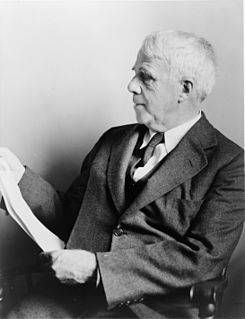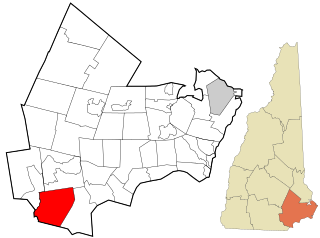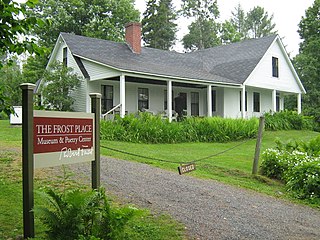
Robert Lee Frost was an American poet. His work was initially published in England before it was published in the United States. Known for his realistic depictions of rural life and his command of American colloquial speech, Frost frequently wrote about settings from rural life in New England in the early 20th century, using them to examine complex social and philosophical themes.

Rockingham County is a county in the U.S. state of New Hampshire. At the 2020 census, the population was 314,176, making it New Hampshire's second-most populous county. The county seat is Brentwood. Rockingham County is part of the Boston-Cambridge-Newton, MA-NH Metropolitan Statistical Area and the greater Boston-Worcester-Providence, MA-RI-NH-CT Combined Statistical Area. Per the 2020 census, it was New Hampshire's fastest growing county from 2010 to 2020.

Windham is a suburban town in Rockingham County, New Hampshire, United States. The population at the 2020 census was 15,817, up from 13,592 in 2010.

Londonderry is a town in western Rockingham County, New Hampshire, United States. It sits between Manchester and Derry, the largest and fourth-largest communities in the state. The population was 25,826 at the 2020 census. Londonderry is known for its apple orchards and is home to the headquarters of Stonyfield Farm and part of Manchester-Boston Regional Airport.

Derry is a town in Rockingham County, New Hampshire, United States. The population was 34,317 at the 2020 census. Although it is a town and not a city, Derry is the most populous community in Rockingham County and the fourth most populous in the state. The town's nickname, "Spacetown", derives from the fact that Derry is the birthplace of Alan Shepard, the first astronaut from the United States in space. Derry was also for a time the home of the poet Robert Frost and his family.

Rhododendron State Park is a public recreation area and nature preserve occupying 2,723 acres (1,102 ha) on and around Little Monadnock Mountain in Fitzwilliam, New Hampshire, United States. The state park contains a 16-acre (6.5 ha) stand of native Rhododendron maximum, the largest of nineteen similar stands in central and northern New England, the northern limit of their growing range. The stand was designated a National Natural Landmark in 1982. The park also includes wild blueberries, cranberries, mountain laurel, heathers, mayflower, and wintergreen.

Saint-Gaudens National Historical Park in Cornish, New Hampshire, preserves the home, gardens, and studios of Augustus Saint-Gaudens (1848–1907), one of America's foremost sculptors. This was his summer residence from 1885 to 1897, his permanent home from 1900 until his death in 1907, and the center of the Cornish Art Colony. There are two hiking trails that explore the park's natural areas. Original sculptures are on exhibit, along with reproductions of his greatest masterpieces. It is located on Saint-Gaudens Road in Cornish, 0.5 miles (0.80 km) off New Hampshire Route 12A.
This is a list of the National Register of Historic Places listings in Rockingham County, New Hampshire.

Bear Brook State Park is a 10,000-acre (4,000 ha) preserve in Allenstown, New Hampshire, and neighboring towns. It is one of New Hampshire's largest state parks.

The Matthew Thornton House is a historic house and National Historic Landmark in Derry, New Hampshire. It was from 1740 to 1779 the home of Matthew Thornton, a Founding Father and signer of the U.S. Declaration of Independence.

The Robert Frost Farm, also known as the Homer Noble Farm, is a National Historic Landmark in Ripton, Vermont. It is a 150-acre (61 ha) farm property off Vermont Route 125 in the Green Mountains where American poet Robert Frost (1874-1963) lived and wrote in the summer and fall months from 1939 until his death in 1963. The property, historically called the Homer Noble Farm, includes a nineteenth-century farmhouse and a rustic wooden writing cabin. The property is now owned by Middlebury College. The grounds are open to the public during daylight hours.

The Newtonville Historic District is a historic district in the village of Newtonville, in Newton, Massachusetts. The district encompasses the southern portion of the village's business district, as well as surrounding residential areas. It was listed on the National Register of Historic Places in 1986, and enlarged in 1990.

The Merrimack Valley is a bi-state region along the Merrimack River in the U.S. states of New Hampshire and Massachusetts. The Merrimack is one of the larger waterways in New England and has helped to define the livelihood and culture of those living along it for millennia.

The Frost Place is a museum and nonprofit educational center for poetry located at Robert Frost's former home on Ridge Road in Franconia, New Hampshire, United States. The property was listed on the National Register of Historic Places in 1976.
Robert Frost Farm may refer to:

The Taylor Mill State Historic Site is a state park of New Hampshire located in 71-acre Ballard State Forest in Derry, Rockingham County, in the southeast part of the state. The site is created to protect the 1799 mill known as Taylor Up and Down Sawmill. The sawmill is in operation and is open for visitors on weekends during the summer. The site is located on Island Pond Road, east of the downtown of Derry.

Ballard State Forest is a state forest of New Hampshire located in Derry, Rockingham County, in the southeast part of the state. The area of the park is 71 acres (0.29 km2). It includes the Taylor Mill Historic Site, an old sawmill, and Ballard Pond, which provides water for the mill. The forest is located on Island Pond Road, east of the downtown of Derry. The pond drains via Taylor Brook and Island Pond into the Spicket River, a tributary of the Merrimack River.
White Lake State Park is a 902.7-acre (365.3 ha) public recreation area in Tamworth, New Hampshire. The state park surrounds 125-acre (51 ha) White Lake, a typical glacial lake. It is open year-round and offers swimming, hiking, non-motorized boating, picnicking, trout fishing, winter sports, day-use area, group areas, and seasonal camping.





















